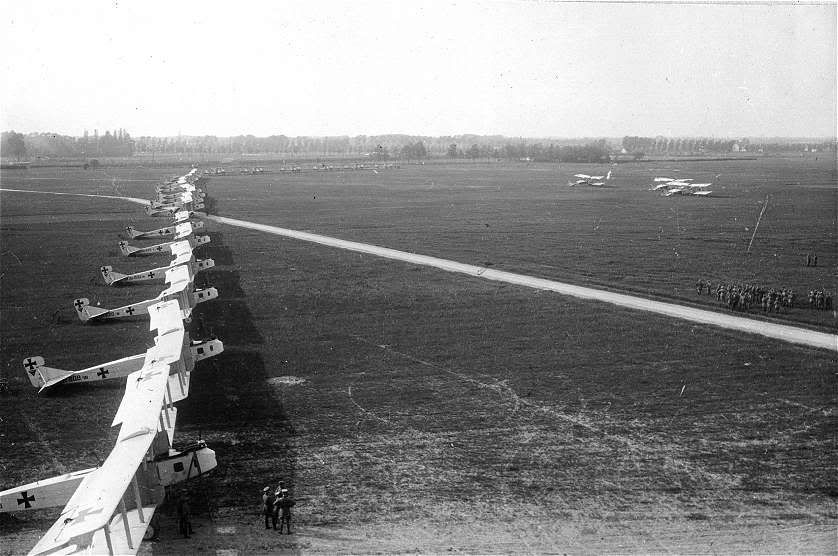 Gontrode
Gontrode
Validation date: 24 06 2015
Updated on: Never
Views: 25983
See on the interactive map:
50°58'52"N 003°47'10"E
Runway: NE/SW - 600m - concrete (estimated)
Runway: WNW/ESE - 500m - concrete (estimated)
Gontrode airfield (Dutch: Vliegveld Gontrode) was an airfield 42 kilometer west-northwest of Brussels.
It was built in 1914 by the German occupation forces fighting on the Western Front during World War I. It was a full flegded airfield, although a satelllite of St. Denijs-Westrem, on the outskirts of Ghent. Its "raison d'etre" being a capability to hit the Western Front from the air, but Great Britain was also a possible target.
In 1915, the airfield was expanded with a Zeppelin capability. Gontrode was chosen over St. Denijs because the latter was too small and because Gontrode was further away from population centers. Additionally, St. Denijs was bombed too often by Allied aircraft. A colossal hangar was built to station the airship, known by locals as "Het Kot" (the shack) or "De Tent" (the tent). Depending on the source, it measured 180 meter in length, a height of 15-49 meters and a width of 40-86 meters. Initially intended to be used by Zeppelin airships, the hangar was ultimately mainly used to shelter aircraft. For its construction, the Germans used the raiload between Brussels and Oostend, which could not be used because of the war.
On the opposite side of the airfield, near Lemberge's windmill a large cable balloon, locally known as "'t Verken van de Keizer" (the Kaiser's Hog) was often flown. It served as a beacon, initially only for the airships, but later also for the other pilots trying to find their home base.
On 22 February 1915 the first Zeppelin (LZ33) landed at Gontrode, but only as the vehicle approached its hangar did it light its floodlights. It took until the next morning 6:30 before the local people saw the airship, which was already underway to Brussels. From then on the quiet night skies were frequently disturbed by passing airships. LZ33 was shot down shortly after this and its replacement was LZ235. This airship was used mainly to bomb targets over the Western Front. During an attack on Paris in the night of 20 and 21 March 1915 it was severely damaged and it only just managed to limp back to Gontrode. Shortly after airship LZ37 was shot down over Gontrode, while returning from a four ship night attack on London. The base then stopped being a support station for Zeppelins as it was deemed to be no longer safe from enemy attack. Only emergency landings were permitted.
On 18 April 1915 the base was bombed by an allied bomber. In spite of severe artillery and machinegun fire, the aircraft managed to drop two bombs, one falling just short of and the other one on the hangar, severely damaging the roof. The Allied bomber managed to escape.
The Gontrode hangar seen from the inside. The man in the foreground gives scale to the size of the building, capable of holding a Zeppelin airship (hetvliegveldvangontrode.be)
In 1917 St. Denijs and Gontrode airfields were taken over by the Kampfgeschwader der Obersten Heeresleitung 3 (KAGOHL 3). Their 36 Gotha IV bombers were dispersed over the two airfields and from late May 1917 these bombers began their daily bombruns on England, with Staffel15 and -16 operating out of Gontrode. For these aircraft, two crossing runways were constructed at the airfield. About 30 of these giants could be observed by the locals, battling Westerly winds in a loose formation. Soon the daily runs were replaced by nightly runs and two extra auxiliary airfields were built in Mariakerke and Oostakker to support these mission.
In July 1917 the Gotha's were backed up by 6 Staaken IV and some 20 smaller single seaters. The Staakens had a crew of 8 and could carry up to 3.5 tons of bombs. Initially operating out of St. Denijs and Gontrode, they were intended to be used from a new airfield at Scheldewindeke for which construction had just begun. For the time being however, they operated from Gontrode and St. Denijs, bombing places like London (September 1917) and Calais (January 1918). The bombers moved out to Scheldewindeke in March 1918. When Allied raids increased in intensity, most aircraft were brought to Scheldewindeke.
The Germans vacated the airfield in October 1918. After the ceazefire they destroyed most of what was left, including the large hangar.
Aerial view of Gontrode Aerodrome. 13th July 1917 (© IWM (Q 12263))
Aerial view of Gontrode Aerodrome. 27 September July 1917 (© IWM (Q 12265))
A long row of Gotha bombers at Gontrode in 1917 (Militaria)
After the war, the airfield was demolished almost completely in 1920. Only two concrete shelters remained. The terrain lost its airfield function definitively. 100 years of history means that almost all remains have vanished, except the two bunkers/shelters, located just west of the village of Gontrode.